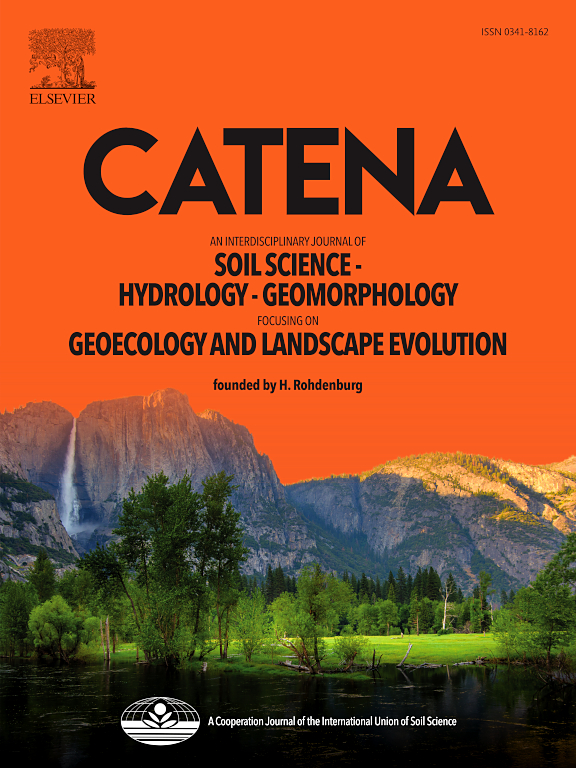A scaling approach for binary and grey computed tomography imaging of soil: A study in a coastal reclamation area
IF 5.4
1区 农林科学
Q1 GEOSCIENCES, MULTIDISCIPLINARY
引用次数: 0
Abstract
Coastal reclamation areas are considered important reserve land resources. The short formation time of cultivated soil in coastal reclamation areas makes the soil structure prone to considerable changes under the influence of reclamation activities, which affect the soil functions. Based on computed tomography (CT) scan images, different scaling and descriptive statistical analyses enable a thorough study of soil pore structure or architecture. This study compares scaling analyses of grey and binary CT scan images of soil samples from different coastal reclamation areas, a 512 voxel cube. Two methods were applied for the analyses, including multifractal analysis (MFA) and relative entropy (). The results revealed that the MFA and parameters of grey and binary images differed. In MFA, grey images exhibited stronger multifractal characteristics. By contrast, better exhibited pore heterogeneity in binary images. Therefore, in analysing the scaling characteristics of the soil pore structure, MFA is recommended for grey images and for binary images. When evaluating the scaling characteristics of the pore structure in coastal reclamation soils at different depths and reclamation years, the topsoils (0–20 cm) exhibited higher amplitude () values, smaller asymmetry () values, greater maximum and wider ranges of compared to the deep soils (20–60 cm). Reclamation activities significantly improved the pore structure of the topsoils, resulting in enhanced complexity and heterogeneity of pores. The decrease in bulk density and increase in soil organic matter caused by reclamation activities were the main factors that enhanced the complexity and heterogeneity of pores. However, differences in scaling parameters among soil samples with different reclamation years were not significant. In addition, the correlation between pore scaling and pore structure parameters was statistically significant (p < 0.05). The morphology of soil pores can be obtained through MFA and , thus simplifying the studied pore parameters. However, there was no significant relation between the connectivity density and scaling parameters of the pores, which can complement pore structure information.
土壤二值和灰色计算机断层成像的标度方法:沿海填海地区的研究
海岸填海区是重要的后备土地资源。海岸带垦区耕地土壤形成时间短,在垦殖活动的影响下,土壤结构容易发生较大变化,影响土壤功能。基于计算机断层扫描(CT)图像,不同的尺度和描述性统计分析使土壤孔隙结构或结构的深入研究成为可能。本研究比较了不同海岸填海区土壤样本的灰度和二值CT扫描图像的尺度分析,这是一个512体素的立方体。采用多重分形分析(MFA)和相对熵(ΔE)两种方法进行分析。结果表明,灰度图像和二值图像的MFA和ΔE参数存在差异。在MFA中,灰度图像表现出较强的多重分形特征。相比之下,ΔE在二值图像中表现出更好的孔隙非均质性。因此,在分析土壤孔隙结构的尺度特征时,灰色图像推荐使用MFA,二值图像推荐使用ΔE。在评价不同深度和填海年限的滨海填海土壤孔隙结构的尺度特征时,表层土壤(0 ~ 20 cm)比深层土壤(20 ~ 60 cm)表现出更高的振幅值(Δα)、更小的不对称值(Δf)、更大的最大值ΔE和更宽的范围ΔE。开垦活动显著改善了表层土壤的孔隙结构,增加了孔隙的复杂性和非均质性。垦殖活动引起的容重下降和有机质增加是增加孔隙复杂性和非均质性的主要因素。不同垦殖年限土壤样品的尺度参数差异不显著。此外,孔隙尺度与孔隙结构参数之间的相关性具有统计学意义(p <;0.05)。通过MFA和ΔE可以获得土壤孔隙的形态,从而简化了所研究的孔隙参数。然而,孔隙的连通性密度与尺度参数之间没有显著的关系,这可以补充孔隙结构信息。
本文章由计算机程序翻译,如有差异,请以英文原文为准。
求助全文
约1分钟内获得全文
求助全文
来源期刊

Catena
环境科学-地球科学综合
CiteScore
10.50
自引率
9.70%
发文量
816
审稿时长
54 days
期刊介绍:
Catena publishes papers describing original field and laboratory investigations and reviews on geoecology and landscape evolution with emphasis on interdisciplinary aspects of soil science, hydrology and geomorphology. It aims to disseminate new knowledge and foster better understanding of the physical environment, of evolutionary sequences that have resulted in past and current landscapes, and of the natural processes that are likely to determine the fate of our terrestrial environment.
Papers within any one of the above topics are welcome provided they are of sufficiently wide interest and relevance.
 求助内容:
求助内容: 应助结果提醒方式:
应助结果提醒方式:


